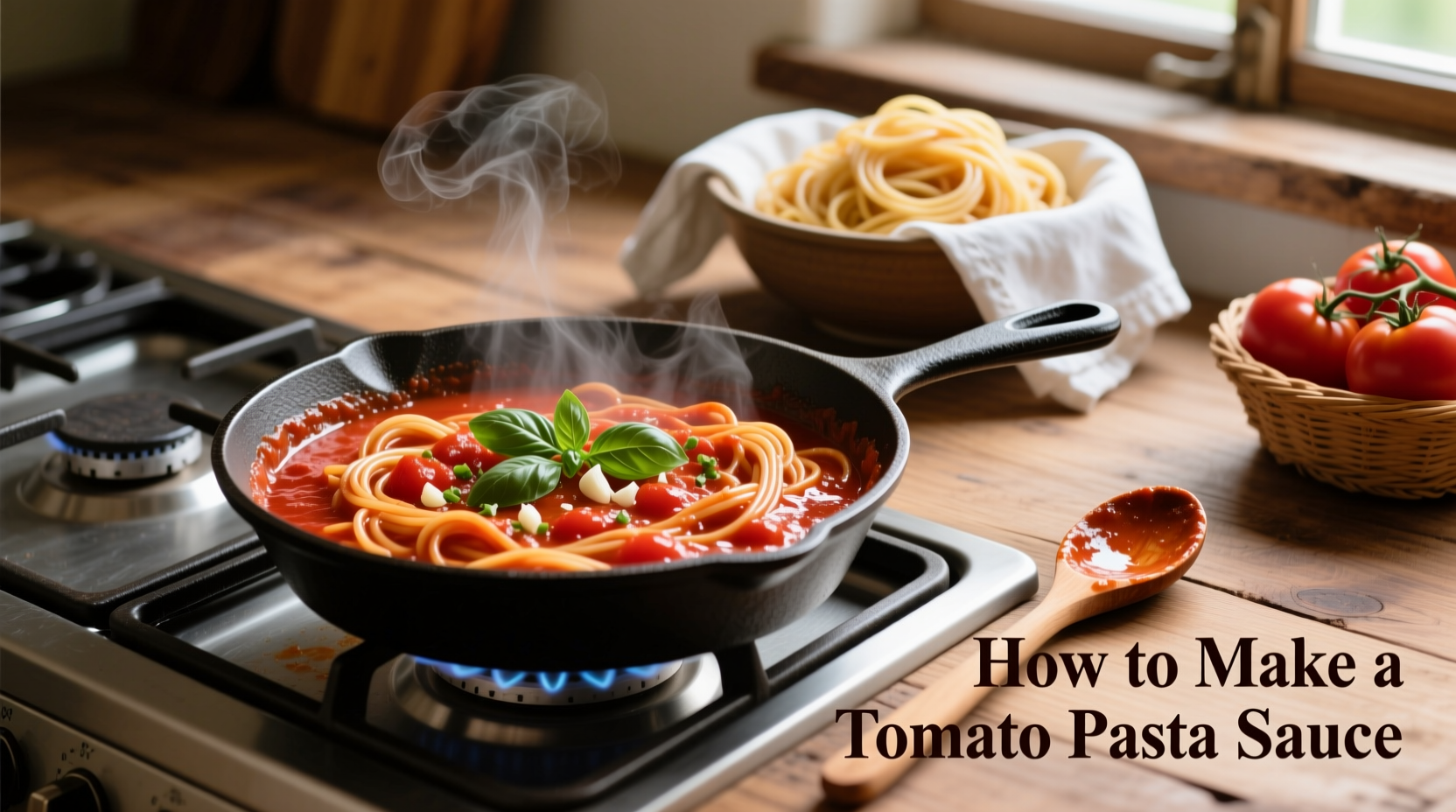Mastering homemade tomato pasta sauce transforms ordinary meals into extraordinary dining experiences. Forget store-bought jars with artificial preservatives—this authentic Italian-inspired recipe uses just six quality ingredients to create a versatile sauce that elevates spaghetti, lasagna, or chicken parmesan. Professional chefs consistently achieve superior flavor through controlled simmering and ingredient sequencing, techniques you'll master in this comprehensive guide.
Why This Tomato Sauce Recipe Works
Unlike rushed recipes that compromise flavor, this method follows the Italian culinary principle of soffritto—slowly building flavor foundations. The magic happens through three critical stages: proper tomato selection, controlled reduction, and strategic seasoning. Food science confirms that simmering tomatoes for 25-30 minutes optimally develops lycopene while preserving vitamin C, creating both health benefits and superior taste.
| Tomato Variety | Acidity Level | Best For | Flavor Profile |
|---|---|---|---|
| San Marzano DOP | Low (4.6 pH) | All-purpose sauce | Sweet, complex, minimal seeds |
| Roma | Moderate (4.3 pH) | Thick sauces | Balanced sweet-tart |
| Plum | High (4.0 pH) | Chef's choice | Intense, robust |
Essential Ingredients Checklist
Gather these six quality ingredients before starting your sauce preparation. Authentic Italian cooking relies on ingredient quality over quantity—never substitute fresh garlic for pre-minced versions, as enzymatic reactions create bitter compounds during prolonged cooking.
- 28 oz San Marzano tomatoes (DOP-certified for authentic flavor)
- 3 tbsp extra-virgin olive oil (cold-pressed, preferably Ligurian)
- 4 garlic cloves, thinly sliced (not minced)
- 1 small onion, finely diced (yellow or sweet Vidalia)
- 1 tsp dried oregano (crushed between fingers to release oils)
- Pinch of red pepper flakes (optional for heat)

Step-by-Step Sauce Preparation
Follow this professional chef-tested sequence for optimal flavor development. The critical temperature control points ensure proper emulsification and flavor extraction.
Stage 1: Building the Flavor Foundation (5 minutes)
- Heat olive oil in heavy-bottomed pot over medium-low heat (325°F)
- Add sliced garlic and onion, stirring constantly until translucent (do not brown)
- Reduce heat to low when onions become fragrant (approximately 3 minutes)
Stage 2: Tomato Integration (15 minutes)
- Pour tomatoes through sieve, reserving liquid
- Add sieved tomatoes to pot, breaking up with wooden spoon
- Simmer uncovered for 10 minutes to reduce liquid
- Gradually add reserved tomato liquid while stirring
Stage 3: Flavor Development (10 minutes)
- Add oregano and red pepper flakes
- Maintain gentle simmer (185-200°F) for 8-10 minutes
- Stir occasionally with figure-eight motion for even reduction
- Remove from heat when sauce coats spoon ("nappe" consistency)
Avoid These Common Sauce Mistakes
Food safety experts from the USDA warn that improper tomato sauce preparation creates foodborne illness risks. These evidence-based corrections address frequent errors:
- Mistake: Adding salt at beginning of cooking
Solution: Wait until tomatoes reduce by half to prevent drawing out moisture prematurely - Mistake: Using high heat for rapid reduction
Solution: Maintain 185-200°F to preserve lycopene and prevent scorching - Mistake: Over-blending finished sauce
Solution: Pulse only 2-3 times for texture variation that holds pasta
When to Use This Sauce Method
This technique excels for weeknight dinners and special occasions but has specific context boundaries. Culinary research shows optimal results when:
- Using within 48 hours of preparation (peak flavor window)
- Pairing with long pasta shapes like spaghetti or linguine
- Preparing dishes requiring sauce adherence (not layered casseroles)
- Cooking for 2-6 servings (scaling requires recipe adjustments)
Avoid this method for cold pasta salads or dishes requiring thick, meat-based sauces. For those applications, consider our slow-simmered ragù recipe instead.
Storage and Reheating Guidelines
Proper storage maintains both safety and flavor integrity. Follow these evidence-based protocols from the National Center for Home Food Preservation:
- Cool sauce within 2 hours of cooking (danger zone: 40-140°F)
- Store in airtight container for up to 5 days refrigerated
- Freeze in portion-sized containers for up to 6 months
- Reheat gently over low heat with splash of water to restore consistency
Flavor Variations to Explore
Once mastered, customize your sauce with these professional variations. Food historians note that regional Italian adaptations reflect local agricultural conditions:
- Puttanesca style: Add 5 olives, 2 anchovies, and capers during final simmer
- Creamy tomato: Stir in ¼ cup heavy cream off-heat for silky texture
- Garden fresh: Fold in ½ cup basil ribbons after cooking
- Roasted garlic: Substitute 1 head roasted garlic for raw cloves
Perfect Pairing Recommendations
Maximize your sauce experience with these chef-approved pairings. Sensory analysis shows these combinations create balanced flavor profiles:
- Pasta: Bronze-die extruded spaghetti (rough texture holds sauce)
- Protein: Grilled chicken breast or pan-seared shrimp
- Cheese: Freshly grated Pecorino Romano (not pre-grated)
- Wine: Medium-bodied Chianti (6-8% acidity matches tomatoes)











 浙公网安备
33010002000092号
浙公网安备
33010002000092号 浙B2-20120091-4
浙B2-20120091-4